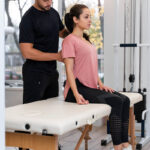
Maintaining proper posture is essential for both your health and appearance. Over time, bad posture can lead to neck pain, muscle strain, and a host of other discomforts. However, physical therapy exercises for posture can help you realign your body, correct muscle weakness, and ultimately improve how you stand, sit, and move throughout your day. In this blog, we’ll cover the best physical therapy for posture improvement, offer tips to maintain your neutral position, and explore the most effective exercises to help you correct long-term postural habits.
What is Poor Posture?
Research has shown that between 34% and 50% of children and adolescents experience varying degrees of poor posture. Poor posture occurs when the body is positioned in a way that puts unnecessary strain on muscles, joints, and ligaments over an extended period of time. This can happen during daily activities such as sitting at a desk, standing for long hours, or lifting objects without proper form. In particular, hip flexors can become tight muscles, and shoulder muscles may weaken, contributing to postural issues such as slouching or rounded shoulders.
Why is Good Posture Important?
Achieving and maintaining proper posture is crucial for overall well-being. A good evidence of this is a research where a posture correction exercise program done for 20 minutes, 3 times a week for 8 weeks, helped reduce shoulder, mid back, and low back pain. Here are a few more key reasons why good posture matters:
- Prevents neck pain and back pain: Keeping your spine aligned reduces the strain on your back and neck, helping to prevent neck pain and discomfort caused by muscle strain.
- Improves breathing and digestion: When your body is in a neutral position, your lungs can fully expand, improving oxygen intake, while good posture helps your digestive organs work more efficiently.
- Boosts energy and confidence: Standing and sitting tall can reduce fatigue and improve your energy levels. Good posture also enhances your confidence, as you’ll naturally appear more poised and self-assured.
How Effective is Physical Therapy for Improving Posture?
Poor posture is a common issue that can negatively impact your appearance, confidence, and overall well-being. Fortunately, it can be improved with regular posture exercises and, if needed, by using posture correction devices. Physical therapy for posture correction is a proven method for addressing postural issues. With correct exercises tailored to your specific needs, physical therapists work to strengthen your core strength, stretch tight muscles, and guide you toward better postural habits. These types of exercises are designed to target areas such as the shoulders, back, hips, and core, all of which play a role in maintaining proper posture.
Incorporating physical therapy exercises for posture into your daily routine can help correct muscle weakness, improve alignment, and reduce the risk of injury. Whether you are looking for “physical therapy for posture near me” or are simply looking for posture exercises you can do at home, the right exercise program can make a significant difference.
10 Physical Therapy Exercises for Improving Posture
Incorporating physical therapy exercises for posture into your routine can help correct misalignments, strengthen weak muscles, and improve overall body mechanics. These exercises target key areas like the shoulders, back, and core to promote better posture and reduce pain associated with slouching or poor alignment. Let’s explore 10 effective exercises designed to improve your posture and keep you feeling your best.
1. Shoulder Retraction
This simple exercise targets the shoulder muscles that help keep your shoulders back and aligned with your spine. It’s an effective way to combat poor positions such as rounded shoulders.
How to do this:
- Sit or stand in a comfortable position with your back straight.
- Pull your shoulder blades back and down, as if squeezing them together.
- Hold for 5-10 seconds, then relax.
- Repeat 10 times.
2. Cat-Cow
The Cat-Cow stretch, commonly practiced in yoga, is an effective exercise to improve flexibility in the spine and increase core strength. It also helps release tension in the lower back and shoulders.
How to do this:
- Start in a seated position or on your hands and knees in a half-kneeling position.
- Inhale as you arch your back, lifting your head and tailbone (cow position).
- Exhale as you round your back, tucking your chin towards your chest (Cat Pose).
- Repeat the sequence 10-15 times.
3. Thoracic Extension

This exercise targets the upper back, addressing common postural issues such as slouching. It is particularly useful for people who spend long hours sitting at a desk.
How to do this:
- Sit on the floor with your knees bent and feet flat.
- Place your hands behind your head, keeping your elbows wide.
- Lean backward over a foam roller positioned under your shoulder blades, extending your upper back.
- Hold for 10-15 seconds, then return to the starting position.
- Repeat 5 times.
4. Seated Row
The seated row is one of the most important physical therapy exercises for posture. It strengthens the muscles in your upper back, promoting proper alignment in the shoulders and spine.
How to do this:
- Sit on the floor with your legs extended in front of you.
- Wrap a resistance band around your feet and hold the ends with both hands.
- Pull the band toward your torso, keeping your elbows close to your sides.
- Squeeze your shoulder blades together as you pull.
- Slowly release and repeat for 10-12 repetitions.
5. Forward Lunge
The forward lunge activates the muscles in your legs and core, helping you maintain stability and balance, which are essential for proper posture.
How to do this:
- Stand tall with your feet hip-width apart.
- Step forward with one leg, lowering your hips until both knees are bent at 90-degree angles.
- Push through the front heel to return to the starting position.
- Repeat on the other leg, alternating for 10 repetitions per side.
6. Pectoralis Stretch
This stretch helps counteract tightness in the chest and shoulders, which is a common cause of bad posture. It’s an essential part of any corrective exercise routine.
How to do this:
- Stand in a doorway with your arms at 90-degree angles and hands on the frame.
- Lean forward gently until you feel a stretch in your chest.
- Hold for 20-30 seconds, then relax.
- Repeat 2-3 times.
7. Plank Pose
The plank position is a powerful way to strengthen the core muscles that support your spine. A strong core is vital for maintaining a neutral position and preventing slouching.
How to do this:
- Start in a push-up position with your hands under your shoulders and feet hip-width apart.
- Keep your body in a straight line from head to heels, engaging your core and glutes.
- Hold for 20-30 seconds, gradually increasing the time as you get stronger.
8. Towel/Foam Roll Stretch
This simple exercise stretches your spine and opens your chest, which helps to alleviate the effects of bad posture caused by sitting or slouching for long periods.
How to do this:
- Lie on your back with a rolled-up towel or foam roller placed along your spine.
- Extend your arms out to the sides with palms facing up.
- Relax into the stretch, allowing your chest to open.
- Hold for 1-2 minutes, breathing deeply throughout.
9. Superman
The Superman exercise strengthens the lower back, glutes, and shoulders, all of which contribute to better posture and a more stable spine.
How to do this:
- Lie face down with your arms extended in front of you and legs straight.
- Simultaneously lift your arms, chest, and legs off the ground.
- Hold for 3-5 seconds, then slowly lower back down.
- Repeat for 10-12 repetitions.
10. Neck Stretch
This stretch helps relieve tension in the neck and upper back, which often results from bad posture and muscle weakness in the neck.
How to do this:
- Sit or stand with your back straight.
- Gently tilt your head to one side, bringing your ear toward your shoulder.
- Hold for 15-20 seconds, then switch sides.
- Repeat 2-3 times on each side.
Tips to Maintain Good Posture Every Day

Maintaining proper posture throughout your daily life requires consistent effort and awareness. Here are some tips to incorporate into your daily routine:
- Be mindful of your posture: Regularly check your shoulder height and spine alignment, whether you’re sitting, standing, or walking.
- Set up an ergonomic workspace: Make sure your chair, desk, and screen height support a neutral position while you work.
- Incorporate posture exercises into your daily routine: Make time for simple exercises that target core strength and flexibility.
Conclusion
Improving your posture with physical therapy for posture correction is achievable through consistent effort and the right exercises. By practicing these corrective exercises regularly, you can correct postural issues, improve alignment, and ultimately lead a healthier, more confident life.
At Scottsdale Physical Therapy, we specialize in personalized treatment plans designed to improve your posture and overall well-being. Our expert team offers targeted exercises that address common issues such as back pain and neck pain, helping you find lasting relief and regain your confidence. Whether you’re looking to correct poor posture, alleviate discomfort, or prevent future injuries, Scottsdale Physical Therapy is committed to delivering exceptional care and tailored solutions to enhance your quality of life.
FAQs
How to correct body posture?
Correcting body posture involves a combination of physical therapy exercises for posture, stretching, and building core strength. A personalized exercise program that includes stretches for tight muscles and strengthening for muscle weakness can effectively address postural habits.
Can physical therapy correct posture?
Yes, physical therapy for posture is an effective way to correct postural issues. A trained therapist can identify areas of imbalance and recommend types of exercises that target weak or tight muscles, helping you regain proper posture.
What is the best method for posture correction?
The best method for posture correction is a combination of physical therapy exercises, correct exercises for core and back muscles, and maintaining awareness of your posture throughout your daily life.









